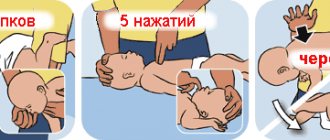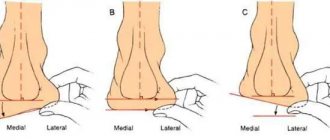What consequences are possible if the thermometer is damaged?
Mercury belongs to the first toxicity class poisons. This means that once the substance enters the body, the dangerous consequences are irreversible.
Mercury itself is practically not dangerous, but since it is the only metal that remains in liquid form under room conditions, its vapors and inorganic compounds (sublimate, calomel, mercuric cyanide) are dangerous. It evaporates at a temperature of +18 degrees, and the rate of its evaporation is 10,000 times less than the rate of evaporation of water.
A regular thermometer contains 1–2 grams of mercury. This is enough to poison all family members in the room where the thermometer broke. The danger also lies in the fact that the small balls are very mobile. They can scatter on the floor and roll into hard-to-reach places, from where they will evaporate for ten years, poisoning everyone around.
Please note that mercury can accumulate in the body. This means that if a substance sufficient to cause poisoning is ingested, symptoms may not appear immediately.
In what cases should you call specialists?
The Ministry of Emergency Situations on its official website gives detailed recommendations for the collection of mercury in residential premises. Immediately after the thermometer has broken, it is better to call the rescue service at 101 or 112 and consult with a representative of the Ministry of Emergency Situations on this issue.
Unfortunately, in Russia there is no well-functioning system for organizing the collection and disposal of mercury. In some cases, representatives of the SES and the Ministry of Emergency Situations do not even go to the scene of the incident, and give recommendations for collecting mercury over the phone. If employees refuse to respond to a call, contact a higher authority and ask for help. If you do not get a team to come out, collect the mercury yourself and take it to a radioactive waste collection point.
In megacities, there are often private companies that collect and dispose of the remains of broken thermometers and mercury. They also check the air for fumes. However, since these firms are private, you will have to pay to call a specialist.
The child bit through the thermometer and swallowed mercury
Sometimes it turns out that they didn’t keep an eye on the child and came after the incident, and it’s quite possible that the baby, having “crashed” a useful thing, at the same time tried the cute mercury balls that rolled out of the broken thermometer on his tongue and even swallowed it. The situation is, of course, unpleasant, but, we repeat, not particularly critical, since the concentration of mercury in household appliances is too low to pose a serious threat to the child’s body.
A child who has swallowed mercury from a thermometer should be shown to a doctor.
But it is still necessary to show the baby to a doctor. Sometimes the baby does not drop the thermometer, but, for example, bites it, chews it, and as a result scratches his tongue, lips with fragments, and often swallows a fragment, and in such a case the consequences are much more dangerous than mercury in low concentrations.
What should not be done if a thermometer breaks in the room?
In order not to aggravate the problem, and not to scatter mercury around the room even more, under no circumstances:
- Do not touch mercury with bare hands.
- Don't sweep up the mercury. The broom will break it into smaller particles and scatter it around the room even more.
- Don't vacuum. When using a vacuum cleaner, warm air is released, which promotes the rapid evaporation of the substance.
- Do not use a magnet. Not only will it not collect the balls of the substance, but it will also scatter them around the room even more.
- Don't wash the floor. A damp or dry cloth will only rub the mercury over the surface being treated.
- Do not throw the collected thermometer fragments and mercury into the garbage disposal, as it will continue to evaporate there.
- Do not flush the substance down the toilet or sink, as the mercury will settle on the pipes and continue to evaporate.
- Do not create drafts in the room, otherwise mercury vapor will spread over a large area.
- Do not bury or burn the substance, causing irreversible consequences for the environment.
- Do not wash items that have been exposed to mercury, but rather recycle them.
- Do not turn on the air conditioner, otherwise mercury vapor will settle on its filter.
Be sure to read the guidelines for disposing of mercury at home.
What to do if a thermometer is broken in the house
A thermometer, of course, is not a toy, and you shouldn’t give it to children again, but anything can happen. If your child has broken a thermometer, you need to quickly:
- take the baby out of the room;
- remove fragments of a broken device;
- collect and dispose of mercury balls.
Keep in mind that mercury balls are very mobile and have the ability to seep into any cracks in the floor. Once stuck there, the mercury will begin to evaporate, posing a threat to the health of children specifically - after all, children are closer to the floor than we are. The mercury balls are small, so collecting them is quite difficult, and with poor lighting, sometimes you can’t even see small drops.
How to collect mercury at home
The main thing is to carry out all the actions correctly and without panic, and first of all call the Ministry of Emergency Situations.
Clearing the premises from strangers
First of all, isolate all people and pets from the premises. Close the door to the room to prevent evaporation from spreading throughout the apartment.
Airing the room
To reduce the room temperature, open a window for ventilation. Also remember to turn off all heating devices if they are on. Your task is to reduce the air temperature so that the mercury does not evaporate.
Be extremely careful not to allow a draft to form in the room, otherwise air vapor will spread the toxic substance throughout the apartment.
How to collect mercury
When all household members have been removed from the apartment, the room is closed, and the windows are open, begin collecting mercury. First of all, prepare the necessary tools and substances. You will need:
- unnecessary clothes that you won’t mind throwing away later;
- latex gloves;
- shoe covers;
- respirator or cotton-gauze bandage;
- safety glasses (if available);
- medical syringe;
- brush;
- paper;
- plaster or tape;
- container with a tight lid for collecting toxic substances;
- flashlight.
Also prepare the demercurization solution in the required quantity in advance.
Procedure:
- Change into old clothes, put gloves on your hands, put a bandage on your face, and shoe covers on your feet.
- Prepare a demercurization solution and pour the required amount into the container.
- Using a wet brush, collect the largest balls onto the paper.
- Aspirate the middle particles of the substance with a syringe.
- Collect the smallest ones with tape.
- Using a syringe needle, remove mercury particles from hard-to-reach places.
- Turn off the lights or close the curtains and shine a flashlight across the floor to spot any remaining glare.
- Place the collected mercury and fragments of the thermometer into a container with the solution and close the lid tightly.
You definitely need to look at the area where the thermometer broke, again using a flashlight.
After this, start cleaning the room. Subsequently transfer the collected mercury to the collection point.
Demercurization
Demercurization is the process of removing mercury using physical methods or chemicals, disinfecting the premises to prevent poisoning of family members. For demercurization, a special solution is prepared, into which the remains of the thermometer are placed and the contaminated surface is treated.
Potassium permanganate solution (potassium permanganate)
For temporary storage and disposal of mercury, use a strong solution of potassium permanganate.
When diluting the substance, focus on the color of the mixture, which should be deep purple. You can use both hot and cold water. Also add salt and vinegar to the liquid at the rate of 1 tbsp. spoon per 2 liters of prepared solution.
Fill a three-liter jar with potassium permanganate solution more than halfway, and place the collected mercury in it. Treat all surfaces that came into contact with the substance with the remaining liquid.
Please note that potassium permanganate can turn things pink, so proceed very carefully.
Be sure to place the broken thermometer and all its elements in a jar of solution, first wearing gloves.
Bleach solution
Both dry lime and liquid bleach, for example “Belizna,” are suitable. Mix 0.5 liters of the substance with 2.5 liters of water. Treat all surfaces in the contaminated room with the prepared solution. After 15 minutes, rinse off the substance with clean water. Repeat the procedure three times to ensure results. When doing this, make sure the room is well ventilated.
Soap and soda solution
This product can be used either independently or in combination with other demercurization methods. Dilute 100 g of soap and 100 g of soda in two liters of warm water. Make sure that the substances are completely dissolved and only then begin processing.
How to finally clean the room?
After collecting mercury, thoroughly treat all surfaces and objects in contact with it with a demercurization solution. For the best effect, use all substances in combination. First, wash all surfaces with a bleach solution, repeating the procedure three times. After drying, treat all items again with a solution of potassium permanganate.
After final cleaning of the room, remove clothing and protective items and pack them in a plastic bag. Rinse your mouth several times with soda solution and wash your body thoroughly. Take an activated charcoal tablet and drink plenty of fluids. Every day for a week, while the room is closed from visitors, treat it with a bleach solution.
Tags: #Yandex.News, #children, #EMS
In order to avoid going to class, the child decided to pretend to be sick. And for this I used the old trick with a thermometer: I dipped it in a kettle of hot water. The thermometer, of course, burst. Distressed by the failure, the malingerer threw out the water with mercury and pieces of glass in the yard and went to class.
The story continued in the evening: the schoolboy drank tea. The water was boiled, of course, in that same kettle... And in the morning the child announced: “I don’t feel well.” The mother began to look for a thermometer. Word by word, it became clear under what circumstances he disappeared. I looked into the teapot and there were droplets of mercury glistening there. What to do in such a situation? The head of the public relations sector of the regional EMERCOM Svetlana Shkinder responded.
— As you know, mercury is a dangerous substance, but it is not the liquid metal itself that causes poisoning, but its vapor. Household medical thermometers contain about 2 grams of mercury. This amount is enough to infect a room or even the entire apartment,” said Svetlana Alexandrovna. — A broken thermometer is the most common cause of mercury vapor entering indoor air.
The main thing not to do when a child has swallowed mercury is to panic, fuss and scare the baby. Most likely, nothing bad will happen if parents follow the recommendations exactly. It is important to consult a doctor in time, without waiting for alarming symptoms to appear: general malaise, apathy and weakness, headache, dizziness, dry mouth, excessive salivation, diarrhea, paroxysmal abdominal pain, difficulty breathing, shortness of breath and cough, increased body temperature. The child will be taken to the hospital, where the stomach will be completely cleaned. By the way, so that children are not afraid to turn to their parents for help, you should not threaten them with punishment for a broken thermometer.
The room itself needs to be cleaned. But first, create the coolest microclimate possible. Thermometer fragments and metal should only be collected using rubber gloves. Large balls can be swept with a damp brush or broom into a plastic or enamel scoop. To collect smaller balls, use medical plaster or tape, pipettes with a rubber bulb, or tampons made from soaked paper or cotton wool. Do not use vacuum cleaners under any circumstances - this way you risk spraying microscopic particles of the substance throughout the apartment. Place the collected mixture in an empty glass jar.
After mechanical cleaning, you can begin chemical demercurization using available means. To prepare solutions, potassium permanganate, or potassium permanganate, as well as various chlorine-containing bleaches and disinfectants are used. After applying the solution, the surface must dry, so you need to wash it thoroughly with detergents. All tools used for cleaning should also be placed in a glass jar, filled with water and tightly closed with a lid.
Next, call the Ministry of Emergency Situations at 112 or 101. They will tell you where you can dispose of the collected mercury and things that came into contact with it. Under no circumstances should collected mercury be poured down the drain or thrown into a garbage chute. This can lead to new stains that are difficult to remove.
To protect your baby forever from such dangerous situations, the thermometer must be kept out of the child’s reach. The easiest way to avoid problems associated with such fragile items is to purchase an electronic thermometer. It costs more, but it will forever eliminate worries about mercury in the house.
Photos from open sources.
How to remove mercury from the floor
If the thermometer breaks on a bare floor covered with linoleum and tiles, it is enough to simply collect the remaining toxic substance using the indicated method. After collecting mercury, be sure to treat the floor with a demercurization solution.
But if the floors in the room consist of wooden boards with many cracks, you will have to completely recycle the covering. The same applies to cases where mercury gets under the baseboard. After dismantling, be sure to pack the boards and baseboards in plastic bags and dispose of them, and treat the cracks with a disinfectant from a spray bottle.
What needs to be done immediately?
If a mercury thermometer breaks in a room: what to do? Parents should take the following safety precautions:
- We open a window in the room where the incident occurred.
- In the room, close the door tightly so that harmful fumes do not spread throughout the apartment.
- We call 01 and inform the Ministry of Emergency Situations about what happened to you.
- There should be no children in the room where the thermometer broke.
- 5. Make sure that mercury does not stick to the sole of the slippers, otherwise it can be spread throughout the house.
- We begin to collect mercury balls. Before work, be sure to put on rubber gloves and shoe covers on your feet (you can use plastic bags secured at the ankles with a rope or elastic band).
- We protect the respiratory organs with a cotton-gauze bandage (pre-moisten it with water or a weak soda solution).
- We collect mercury balls in a glass jar with water. We also put parts of the broken thermometer body there. There must be water in the container, otherwise the mercury will release dangerous fumes.
Interesting! What do schoolchildren do to get sick? Secrets taken from children's forums and their consequences
Can mercury be collected from carpet or upholstered furniture?
If mercury gets on upholstered furniture or carpeting, the best option is to throw it away. If you cannot dispose of carpet or upholstery, follow these guidelines:
- try to collect balls of toxic substances from the fleecy surface as much as possible using a syringe and tape;
- roll the contaminated carpet from the edges to the center to prevent the mercury from spreading across the floor;
- Pack the furniture or carpet in plastic and take it outside;
- move away from residential buildings and crowded places;
- carefully beat the carpet or upholstery over the cellophane;
- leave the item to air for 2–3 hours;
- Afterwards, at home, treat the carpet and upholstery with a solution of potassium permanganate or bleach.
If you doubt that all particles of the substance have been removed from the fleecy surface, it is better to seek help from a specialized service.
Possibility of serious mercury poisoning from a thermometer
A threat appears only if the integrity of the thermometer is compromised. As the mercury flows out, it breaks up into many small balls. They must be collected fairly quickly to prevent the spread of vapors. The balls scatter in different directions, rolling into corners, crevices, and getting between the fibers of the carpets. The cleaning process is made difficult not only by its size, but also by the lack of smell.
It is unlikely to get a fatal degree of intoxication from one broken thermometer. The metal content in the thermometer is not enough for acute poisoning. It occurs when inhaling mercury vapor for several hours, while per 1 cubic meter. m must contain at least 10 mcg of toxic substance.
If the cleaning is not carried out thoroughly and the room has not undergone special treatment, there remains a high risk of chronic mercury vapor poisoning. The accumulation of toxic substances in the body proceeds slowly. At the first stage there are practically asymptomatic. Inhaling vapors for several hours can cause a person to feel weak. Later, nausea appears, coordination of movements is impaired and noticeable trembling in the knees appears.
The most dangerous method of poisoning is ingestion of mercury pellets. Most often, children are exposed to this type of intoxication.
By taking the precautions recommended by experts and removing all mercury particles that have rolled out of the thermometer, you can avoid poisoning
What to do if mercury is collected with a vacuum cleaner
If it so happens that the room where the thermometer crashed was nevertheless treated with a vacuum cleaner, reduce the temperature in the room by any means.
Disassemble the vacuum cleaner into parts and put it in a plastic bag. There are 3 possible ways to solve the problem:
- Demercurize the vacuum cleaner yourself. It is extremely difficult to do this at home, since it is not always possible to get to all parts of the device.
- Take the vacuum cleaner to a collection point for hazardous substances.
- Order processing of the device from a specialized company.
Please note that a vacuum cleaner containing mercury should not be thrown into the garbage disposal.
What to do if the thermometer is cracked under the armpit
If mercury gets on your skin, for example, a thermometer breaks right under your arm, do not panic. Since it is not mercury itself that is dangerous, but its vapor, the harm from it will be the same as if a thermometer were broken on the floor. In rare cases, allergic reactions may occur on the skin, which can be treated with standard medications.
To avoid the risk of allergies, immediately after contact with the skin, wash off the mercury with a solution of potassium permanganate. Moisten a cotton sponge with the same solution and hold it where the substance comes into contact with the skin.
Monitor your skin reaction. If no redness or rash appears within 24 hours, then the allergy has not appeared.
What to do if a mercury thermometer breaks and the mercury is not found
In cases where the thermometer broke, but the mercury could not be found, for example, the thermometer was broken by a child in your absence. First of all, it is worth understanding that mercury will not evaporate in such a short time. Try to find the balls of the substance yourself by shining a flashlight on the surface. The particles should shine.
If the thermometer was broken over fluffy upholstery or carpet, you can check for its presence with a homemade brush made of stranded copper wire. To do this, clean the wire from the outer winding, leaving thin copper wires. Use the resulting brush to notice the infected surface. If the ends of the wires change color to white, it means that the mercury still remains and continues to poison you. Take steps to dispose of it immediately.
To sleep peacefully, call a special demercurization service. Its specialists will check the room for the presence of fumes, find the source of infection and neutralize interior items with a special solution.
What to do if a child breaks a thermometer
The main thing is not to scold the child, otherwise next time he will simply keep silent about what happened.
Step by step guide:
- Inspect your child's hair, body, and clothing for mercury particles. If pellets are found, carefully collect them in a jar with demercurization solution.
- Induce vomiting in your child.
- Remove clothing and bathe your child thoroughly.
- Give your baby an activated charcoal tablet and drink plenty of water.
- Take your child out into the fresh air.
- Collect the mercury, treat the room and close it from visitors.
Give your child more fluids throughout the week.
How to dispose of a thermometer with mercury
If you collected mercury yourself and did not seek help from specialists, under no circumstances should you throw the remains of a broken thermometer and the substance itself into the garbage disposal.
Call the Ministry of Emergency Situations, perhaps specialists will recommend to you where to take the collected material. Often in large cities, special containers are installed for collecting batteries and mercury thermometers or a mercury collection point is organized at the central SES or Ministry of Emergency Situations.
If you still haven’t found any options for disposing of mercury, take the container with the collected materials to a remote non-residential area and bury it as deep into the ground as possible.
What to do if you do get poisoned?
Hazardous mercury vapor can cause harm to the body, so monitor your body closely for changes. Intoxication can take place in 2 forms:
- acute, when symptoms appear immediately after contact with the substance;
- chronic, when signs of poisoning become apparent after some time.
The complexity of both forms depends on the individual characteristics of the body and the amount of substance entering the blood.
Symptoms
Symptoms of acute intoxication include:
- weakness;
- headache;
- nausea and vomiting;
- metallic taste in the mouth;
- a sore throat;
- chills;
- diarrhea;
- increased bleeding of gums;
- traces of blood in vomit and feces;
- high salivation;
- cough;
- shortness of breath;
- traces of mercury in urine;
- increase in body temperature.
The chronic form is characterized by the following symptoms:
- severe headache, migraine;
- insomnia;
- loss of appetite;
- tremor of the limbs or the whole body;
- impaired concentration and memory;
- chronic fatigue;
- depression;
- heart rhythm disturbance;
- decrease in blood pressure.
Remember, if you do not pay attention to the symptoms and do not visit a doctor in time, complications in the form of serious illnesses and even death are possible.
First aid
If you notice the first symptoms, call an ambulance immediately. While you are waiting for doctors, provide first aid to the victim:
- rinse the stomach and induce vomiting;
- provide peace;
- give the sorbent to drink;
- drink plenty of water.
If the victim has lost consciousness, lay him on his side and prevent his tongue from sticking. Provide fresh air and loosen clothing that makes breathing difficult.
Prevention of poisoning
If you are unsure that the thermometer will remain intact, it is better to use a mercury-free thermometer to measure body temperature.
If you still prefer mercury devices, follow certain rules for its use and storage:
- keep the thermometer out of the reach of children only in a special case;
- do not let children play with a thermometer;
- When measuring temperature, hold the thermometer tightly under your arm;
- shake the thermometer so that there is free space around your hand.
Do not neglect the rules, and then you will not have to look for ways to solve the problem with a broken thermometer.
What are the signs of mercury vapor poisoning?
We figured out what to do if a thermometer breaks and how to protect yourself as much as possible, but it wouldn’t hurt to know about the manifestations of poisoning with this substance.
Acute vapor poisoning is impossible at home and the cause cannot be a broken thermometer. The condition occurs exclusively during large-scale accidents at enterprises, when the concentration of vapors reaches a critical level and they enter the body in a short period of time.
The first signs of poisoning will be noticeable after 2-3 hours. Most often this is severe malaise, lack of appetite, and headaches. A metallic taste appears in the mouth, it becomes painful and difficult to swallow, the gums become inflamed and begin to bleed. Over time, acute abdominal pain, diarrhea, chills, shortness of breath and difficulty breathing are added to the above symptoms. Body temperature often rises to 40 degrees. Ignoring these symptoms and making an incorrect diagnosis can be fatal.
Chronic mercury poisoning occurs when long-term exposure to the body occurs at relatively low concentrations. Long-term exposure refers to a period ranging from several months to a couple of years.
In case of chronic poisoning, the central nervous system is the first to be affected. In the first stages, drowsiness, excessive fatigue, frequent headaches, and apathy appear. Poisoning the body with mercury vapor also affects a person’s behavior; he becomes irritable, inattentive, and unsure of himself.
Subsequently, such an unpleasant syndrome as mercury tremor appears. Trembling begins with the fingers, then moves to the eyelids and lips; in more severe cases, tremor of the lower extremities and the whole body is observed. In addition, poisoning is often accompanied by loss of taste and skin sensitivity, increased sweating, and an enlarged thyroid gland. The worst thing about chronic poisoning is that all these symptoms and consequences can appear several years after contact with mercury.
Micromercurialism belongs to the category of chronic poisoning and occurs when mercury in negligible concentrations affects a person for 5-10 years. It is possible to find out the cause only if you pay timely attention to a number of symptoms, such as fatigue, increased excitability, and weakened memory.
Micromercurialism can occur even without direct human contact with mercury. It will be enough to be near a room in which a thermometer was once broken; the mercury did not leak out, but was not properly cleaned.
At the first signs of illness with suspected poisoning, you must leave the room and rinse your mucous membranes. This recommendation applies to the nose, mouth and eyes, as well as exposed areas, even if they have not come into contact with mercury. Rinsing can be done with running clean water or a weak solution of potassium permanganate, diluted to a light pink color.
If necessary, gastric lavage can only be done through a tube; other methods will be ineffective and even dangerous. A course of sorbents and intravenous administration of an antidote are also prescribed.
Is there mercury in modern thermometers?
Currently, the variety of thermometers for measuring body temperature is very large. In addition to mercury thermometers, you can find thermometers on sale:
- electronic;
- alcohol;
- infrared;
- galliaceae.
An electronic and infrared thermometer can be easily distinguished from a mercury thermometer. They differ significantly in appearance and nature of application.
Gallium and alcohol thermometers, in turn, strongly resemble mercury ones. They have the same shape of shell, scale, capillary tube.
- An alcohol thermometer can be easily distinguished from a mercury thermometer. It has a red or blue scale, which will simply leak if its integrity is damaged.
- A gallium thermometer measures temperature as accurately as a mercury thermometer. The only difference is the weight of the device: a mercury thermometer will weigh heavier than a gallium thermometer. This can be checked by placing a thermometer in a container of water: a gallium thermometer will float, and a mercury thermometer will sink.
If you break a mercury thermometer, do not panic. The situation can still be saved without infecting the body with harmful fumes. To do this, follow all prescribed rules for treating the premises, collecting mercury and disposing of it. Remember, it is better to prevent a situation than to eliminate the consequences, so be careful when storing the thermometer or replace it with a similar device without mercury.
Is it dangerous to get mercury into the body?
It often happens that a child not only bites through the thermometer, but also swallows mercury from it. Situations like this worry parents a lot. What to do?
Remember, if the baby swallowed a small amount of the substance, it is unlikely to cause harm to health, but you still need to go to the doctor for an examination, since a piece of glass could enter the body with it. Based on this, it can be argued that cases where a child swallows this metal are less dangerous than inhaling its vapors.











